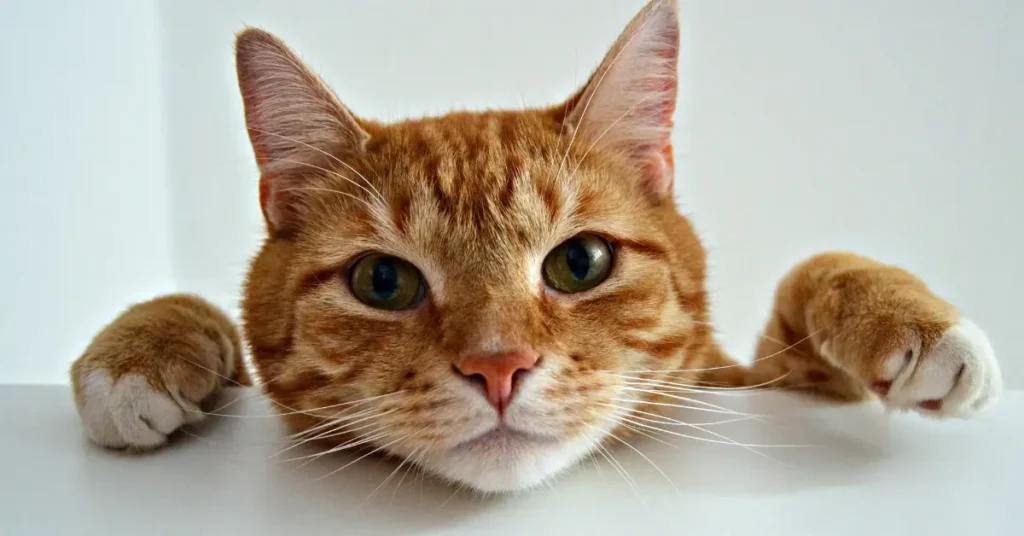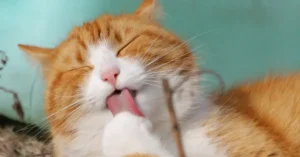Diving into the world of cat face anatomy reveals much more than just those captivating eyes and twitching whiskers. It’s a fascinating exploration of how each feature contributes to a cat’s survival and communication.
Right from the get-go, understanding the intricate details of a cat’s facial structure can unravel mysteries about their behavior and health. Did you know, for instance, that a cat’s whiskers are not just for show?
They’re highly sensitive tools that help them navigate tight spaces and sense changes in their environment. Or that the shape and positioning of their eyes allow for an exceptional field of vision, perfect for their predatory lifestyle?
This brief journey into the anatomy of a cat’s face will not only deepen your appreciation for these enigmatic creatures but also equip you with insights to better connect and care for your furry friend.
So, let’s get up close and personal with the finer points of cat face anatomy, discovering what each whisker, ear, and eye reveals about the feline world.
Head Structure
Exploring cat face anatomy, we unveil a world of fascinating biological engineering. Every aspect from ears to nose is designed to optimize our furry friends’ survival senses.
Ears
Cats possess an extraordinary sense of hearing. Their ears, shaped like satellite dishes, can swivel independently, capturing even the faintest of sounds. This is possible because a cat’s ear contains over two dozen muscles,…
Eyes
A cat’s eyes are a marvel of evolution. Those large, hypnotic eyes house a distinctive pupil that can contract to a vertical slit or expand fully to maximize light intake. This, paired with a reflective layer called the tapetum lucidum, amplifies their vision at night,…
Nose
The feline nose is a powerful scent detector. On the surface, whiskers, or vibrissae, enhance spatial sensing. Cats use their sensitive noses to interpret signals in their environment, heavily relying on scent to navigate and hunt,…
Mouth and Dental Anatomy
We’re about to dive into the fascinating world of cat face anatomy, starting with two of the most captivating features: the mouth and dental architecture. Not just a gateway for meows and purring, this area of a cat’s anatomy is a complex structure designed for precise movements and actions.
Teeth
Cats boast an array of specialized teeth – they possess sharp incisors at the front perfect for meticulous grooming tasks, and pointy canines essential for clamping down on prey. Further back are the premolars and molars, the back teeth, which are not as sharp as the canines but are vital for shearing and grinding food. Adult cats have a dental formula typically comprising 30 teeth, while kittens have a temporary set of 26 deciduous teeth.
Tongue
The feline tongue is an engineering marvel, coated with tiny barbs known as papillae, making it a perfect tool for grooming fur and scraping meat off bones. These barbs are keratinized, aiding in the grooming process. Moreover, the tongue houses taste buds and is instrumental in the feeding process, allowing cats to discern various flavors and textures.
Information about the functionality of the cat’s tongue in relation to their sense of smell can further highlight how these senses work together in felines. Notably, the tongue plays a role in a cat’s use of the Jacobson’s organ or vomeronasal organ, an auxilliary olfactory system that processes pheromones and other chemicals, enhancing their sense of smell and communication abilities.

Facial Communication
We find the intricacies of cat face anatomy utterly enthralling, especially when it comes to how cats communicate with us and each other. Their facial expressions are a complex combination of movements involving various parts of their face, from twitching whiskers to the subtle shifting of eyes. Let’s zero in on how whiskers and eyes play pivotal roles in these often-misunderstood dialogues.
Whiskers
In the cat face anatomy, you need to know that the whiskers, or vibrissae, are not just ordinary hairs; they’re touch-sensitive tools that help cats assess their environment. A cat’s whiskers contain numerous nerve endings that detect even the slightest changes in airflow, allowing them to sense nearby objects without seeing or touching them. Cats also express emotions through their whiskers: for example, whiskers that fan out wide indicate curiosity, while whiskers pulled back against the face suggest fear or aggression.
- Communicative Gestures with Whiskers:
- Forward: Interest, Excitement
- Pinned Back: Anxiety, Threatened
Eyes
The eyes of a cat are windows into their soul, conveying a spectrum of sentiments. Look for changes in pupil size which can range from narrow slits to full round orbs, each signaling a different emotional state. Slit-like pupils often mean a cat is feeling aggressive, while dilated pupils could suggest fear or excitement. Additionally, cats possess a third eyelid, known as the nictitating membrane, which can indicate health or emotional stress when more visible than usual.
- Eye Features & Signals:
- Pupils:
- Dilated: Surprise, Fear, Playfulness
- Constricted: Focus, Agitation
- Third Eyelid Visibility:
- Barely Visible: Relaxed, Healthy
- Partially Visible: Possible Discomfort or Illness
- Pupils:
Through their whiskers and eyes, cats are masters of subtle communication. Observing these features can give us a glimpse into their unseen thoughts and emotions.

Cranial Features
Intrigued by the intricate design of cat face anatomy, we discover that the cranial region is a marvel of biological engineering, comprising an array of bones and muscles meticulously working together. Let’s dive into each component that defines a cat’s head structure.
Bones
The skull of a cat is a complex framework consisting of several bones, which includes the cranial and facial bones. The cranial bones protect the brain, with the main sections being the frontal, parietal, temporal, and occipital bones. The facial bones support sensory organs and include delicate structures such as the nasal and lacrimal bones. Together, these bones provide a strong yet lightweight structure ideal for a predator requiring agility and speed. Relevant information can be uncovered through a closer examination on How Strong Are Cat Skulls?
Muscles
Muscles in a cat face anatomy, such as the zygomaticus muscle, play a crucial role in the animal’s expressive capabilities. These muscles enable a vast range of motions, from subtle whisker twitches to wide mouth movements essential for communication and feeding.
The masseter and temporalis muscles, vital for chewing, are strongly attached to the skull’s zygomatic arch and mandible, ensuring powerful bites. Supporting structures like nerves, blood vessels, and ligaments interweave with the muscles, ensuring coordinated movements and sensation. The Head and neck anatomy of the cat on CT offers detailed insights into the muscular layout and associated structures.

Neck and Posture
We’re diving into the fascinating world of a cat’s neck and how this remarkable part of their anatomy contributes to their elegant posture. In examining cat face anatomy, we can’t overlook the neck—it’s the core of their agility and fluid movements.
Joints
A cat’s neck joints are a marvel of nature, allowing for an impressive range of movement. This dexterity is essential for their survival, aiding in swift directional changes during a chase. The joints work in harmony with a flexible spine, ensuring that our feline friends can twist and turn with astonishing grace.
Vertebrae
The cervical vertebrae play a key role in maintaining a cat’s balance and poise. Each vertebra is interconnected in a way that creates a supremely flexible spine, crucial for their locomotion. This flexibility is not just about agility; it’s integral to their ability to express themselves through body language and quickly react to potential threats or prey.

Sensory Systems
We can’t help but be fascinated by the sensory prowess of cats. Their cat face anatomy is not just a sight to behold, it’s a marvel of nature’s engineering. Specifically, their sensory systems are finely tuned instruments that allow them to interact with the world in ways we can only imagine. Let’s dive into the specifics of their hearing and smell capabilities.
Hearing
Cats have remarkable ears that can detect a wide range of sounds, much beyond our own capabilities. Their ears are designed to pivot up to 180 degrees, allowing them to hone in on the faintest whispers of movement. The unique structure within, including 32 muscles in each ear, grants them the ability to hear higher-pitched tones. This means they can detect the high-frequency noises made by small prey, making them exceptional hunters even in complete darkness.
Smell
The nose plays a central role in the senses of a cat. A feline’s sense of smell is about 14 times stronger than ours, enabling them to pick up on nuances that completely elude us. This acute sense is augmented by whiskers, or vibrissae, which are packed with sensitive nerve endings.
These tactile hairs provide detailed information about their immediate surroundings, enhancing their perception dramatically. The whiskers are so sensitive that they can even detect changes in air currents, aiding in navigation and the detection of potential threats or prey.

Out Thoughts about Cat Face Anatomy
When we explore the marvel of cat face anatomy, it’s like uncovering the blueprint of nature’s fine craftsmanship. Our fascination begins with those captivating feline features, each telling a story of evolution and survival.
Think about their piercing eyes; set like jewels, they grant cats remarkable night vision, making twilight their domain. There is a reason why tales speak of cats and their mysterious gaze—it’s a window into a world powered by acute senses. The slanted eyes give them an edge, a sliver of stealth in the dimmest light.
Here’s a glance at what makes a cat’s face anatomically remarkable:
- Whiskers (Vibrissae): These aren’t just for cuteness; they are a navigational and sensory tool.
- Nose: A superior scent detector that’s always on the job.
- Ears: Their shape and mobility help pinpoint the faintest sounds.
Their jowls can signal aggression or fear when fluffed up. And beneath the skin, the vomeronasal organ acts as an extra layer of sensory perception, receiving pheromones and other chemical communications.
We revel in the details—the tufts of fur, the subtle movements of their ears, the twitch of a whisker. We’ve seen the practical magic in action: whiskers fitting through tight spaces and ears swiveling towards whispers of movement. Exploring the anatomy of a cat’s face isn’t just about understanding how they look; it’s about appreciating the intricate biology that makes them one of nature’s most adept hunters.
Discovering the nuance in cat face anatomy is an ongoing thrill, a testament to the complexity hiding in plain sight. Every glance, every twitch and whisker flick, is a piece of evolutionary art—and we’re here for it.
FAQ Cat Face Anatomy
We’re diving whisker-first into the fascinating world of cat face anatomy! Ever wondered about the myriad of features that make up your feline friend’s adorable visage? Fear not! We’ve compiled some of the most intriguing questions to give you the insights you’re curious about.
What are the parts of a cat’s face called?
A cat’s face is a marvel of predatory design. It’s composed of several key parts: the whiskers, or vibrissae, that provide tactile feedback; the ears, which pivot to catch sounds; piercing eyes with a unique vertical pupil for sharp night vision; and the nose, with an exceptional sense of smell. This Cat Anatomy Guide offers a comprehensive look at each feature.
What muscles do cats have that humans don’t?
Cats possess a unique set of facial muscles not found in humans. These specialized muscles, particularly the levator anguli oculi medialis, allow them to make fine-tuned ear movements, enhancing their ability to pinpoint the origin of sounds. Unlike humans, their highly developed cutaneous maximus enables them to twitch the skin on their back, a trait useful for evading parasites. Delve deeper into the specificities of feline musculature with insights from this vet-reviewed cat anatomy fact guide.
If you are interested in what kind of cat you should choose our article about what cat breed lives the longest, may help you to find a feline friend who will live long with you.
If you would like to know how to draw anime cats, have a look at our guide.
What are your thoughts about our article Cat Face Anatomy? Let us know in the comments 🙂





